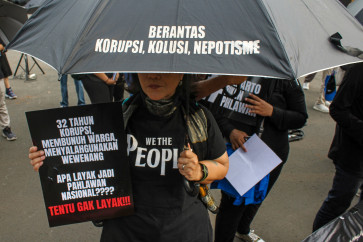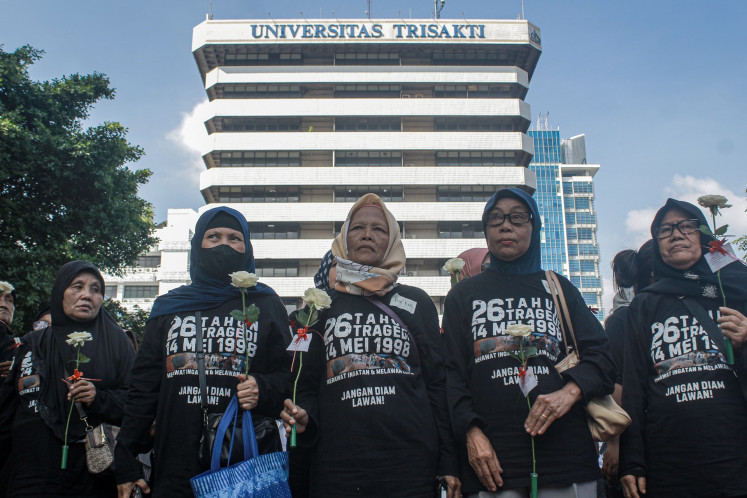REMEMBERING MAY 1998: Documenting the bloodshed
Ghosts of the past: A scene from Tino Saroengalloâs Setelah 15 Tahun (After 15 Years), one of documentaries made on the May 1998 tragedy
Change text size
Gift Premium Articles
to Anyone

G
span class="caption">Ghosts of the past: A scene from Tino Saroengallo's Setelah 15 Tahun (After 15 Years), one of documentaries made on the May 1998 tragedy. Unresolved cases surrounding the event have triggered many fiction and non-fiction works to relive the tragedy. Courtesy of Tino Saroengallo
After ' and even during ' the fall of the New Order dictatorship, filmmakers documented the shooting and riots on the streets.
In the Reform era, filmmakers have explored the aftermath of the killings and what the people of Indonesia have done under deomcracy. Here are some of the films that take as their subject of the fall of New Order.
In The Eye of the Day (2001), Dutch Indo filmmaker Leonard Retel Helmrich captured the riots through what he calls 'single-shot cinema', shooting scene in single takes and relying on camera angles to express personal perception.
What Helmrich documented was explosive: Stormy skies on Jl. Gatot Subroto, marching students beating steel drums labelled 'Reform' and soldiers standing beside tank traps at the House of Representatives while others arrogantly taunt protesters, saying 'Go back to school, schoolchildren.'
In one amazing scene, he zooms between cops, soldiers and protestors before waves of students break through lines of police in riot shields and helmets.
The first local documentary on the subject, Student Movement in Indonesia, directed by Tino Saroengallo, is equally compelling.
Shot in 1998, the film uses footage captured by Tino and other broadcast journalists in the middle of the tumult to chilling effect.
One gruesome scene ' showing a soldier stepping on the head of a student ' was ordered cut by local censors before the film's release, even though it had been broadcast and rebroadcast at the time.
Seperately, four films from 9808: An Anthology of the 10th Year Indonesian Reform stand out for their personal and intimate approaches to what happened after the violence stopped ' and for showcasing directors who have since established themselves as extraordinary filmmakers.
Edwin, for example, famous for the festival favorites Babi Buta Yang Ingin Terbang (The Blind Pig Who Wants to Fly) and Postcards from the Zoo, directed the moving Trip to the Wound, starring Ladya Cherryl as a woman who 'collects' the stories behind people's injuries on a late-night bus trip.
What happened to her in 1998 is a question that the director deliberately ' and masterfully ' leaves ambiguous.
Lucky Kusuwandi, director of the upcoming Selamat Pagi, Malam (Good Morning, Night), contributed A Letter of Unprotected Memories, which remembers how Chinese New Year, proclaimed a national holiday after Reform, was forbidden in his childhood.
The documentary filmmaker Ucu Agustin contributed Yang Belum Usai (The Endless Path), which tells the story of a mother who has spent 10 years fighting for justice after her son, Wawan, was shot dead in Semanggi during the May riot.
Finally, Ifa Isfansyah directed Huan Chen Guang (Happiness), about a 21-year-old Chinese woman in Beijing whose Indonesian mother died in the riots.
Ifa went on to confront another contentious subject ' the bloody purge of the Indonesian Communist Party and its purported sympathizers in 1965 and 1966 in his adaptation of The Dancer.
Meanwhile, Tito recently released a sequel to his 1998 documentary titled Setelah 15 Tahun (After 15 Years), presenting his view on what has happened to the Reform spirit.
But in remembering May 12, the focus should remain on those who the soldiers taunted as 'schoolchildren'.
In Student Movement, Tino showed us how students used Usmar Ismail's patriotic song 'Gugur Bunga di Taman Bakti' (The Fallen Flower in the Garden of Devotion) to commemorate the Trisakti killings.
The song, as film scholar Katinka van Heeren wrote, was the same used to punctuate the climax of Pengkhianatan G30S/PKI, the propaganda film on the bloody birth of the New Order that was forcefed to a generation.
Let us remember, as van Heeren notes, that by the time of the New Order's bloody demise, students were ' with right and justification ' singing the same patriotic song for their peers who had been killed.









